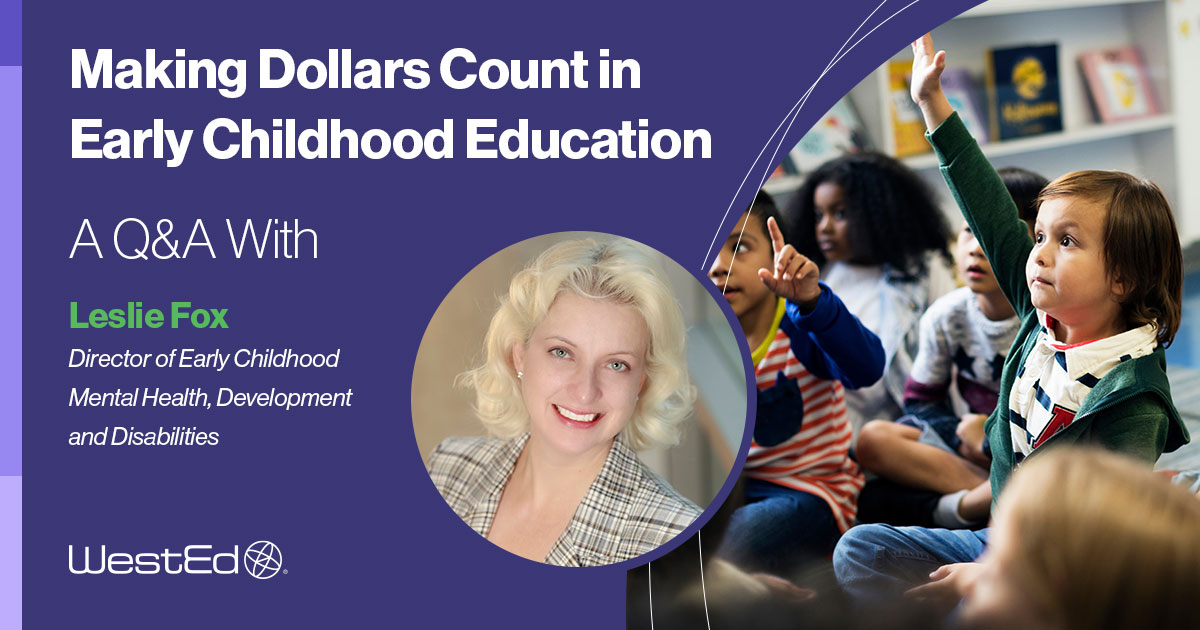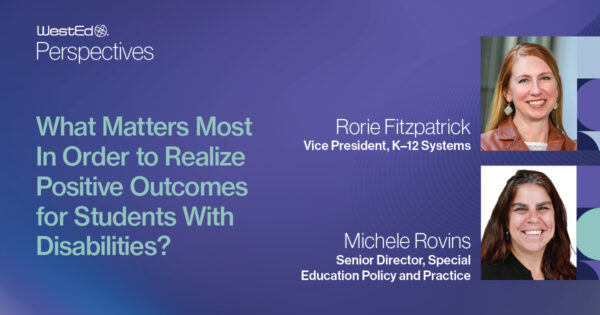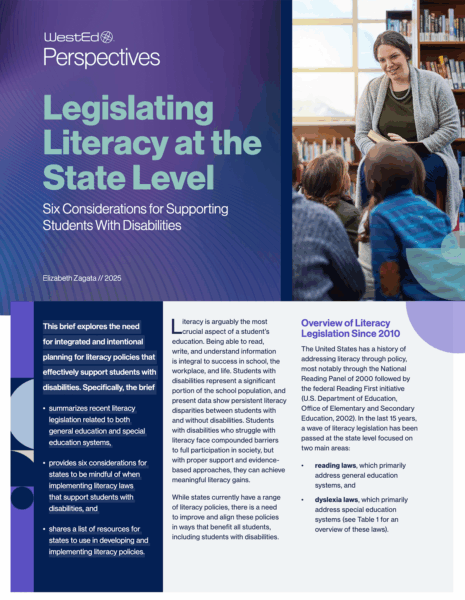
July 28, 2025
Providing opportunities for preschool-age children with disabilities to learn alongside their peers without disabilities is a key component of federal special education law. However, individual state policies supporting access to these settings vary, and national data show that the number of preschoolers with disabilities in general early learning programs has increased very little over the past decade.
The Individuals with Disabilities Education Act (IDEA) requires that children with disabilities be served in the least restrictive environment to the maximum extent appropriate. For preschool-age children, these settings may include Head Start programs, community-based preschools, and district-operated early childhood classrooms. States fund early learning environments by coordinating and maximizing federal, state, and local resources, including grants from the U.S. Department of Education, and they use Medicaid dollars for health-related services such as speech, occupational, and physical therapy and behavioral supports for young children with delays or disabilities.
In this Q&A, Leslie Fox, WestEd’s Director of Early Childhood Mental Health, Development, and Disabilities, explains how states can use strategic funding and cross-program coordination to expand access to high-quality early learning environments for children with disabilities and manage long-term special education costs.
Note: This conversation has been edited for length and clarity.
When we talk about preschool special education, we’re referring to 3-, 4-, and 5-year-olds identified with a developmental delay or disability who qualify for individualized education programs under the IDEA. First, you need to know where children with disabilities are currently being served through your early childhood programs and initiatives. These descriptive data can guide decisions about what to prioritize from a programmatic perspective and how to allocate appropriate fiscal resources.
Next, it’s important to assess your funding streams. Each early childhood program has its own funding sources and related timelines and requirements for the use of those funds. Mapping the funding streams for each federal, state, school, health and human services, and disability service program that supports early childhood services is a critical early step for strong and sustainable finance systems. This includes laying out which systems need to coordinate and how, what initiatives already support young children with disabilities, and what service options exist within these programs. Not every state has universal preK, and even when they do, it may start at different ages, or the quality and availability vary across regions within the state. Some areas do not have Head Start programs, and while private child care is more widespread, quality can vary significantly. So, you start by understanding your systems, services, and funding and then return to the data to guide you on what to sustain, what to change, and what gaps need to be filled.
Cost modeling is an interesting approach that’s been around for a long time. Components of cost modeling, including finance mapping, provider rate studies, program cost estimations, and cost-benefit studies, contribute important information for aligning fiscal resources across early childhood initiatives, programs, and services.
Cost models help program leaders account for the full range of factors tied to the true cost of providing care or delivering a service. Typically, when we think about the cost of a program, we focus on market rates—for instance, in child care, that would be what parents can afford or are expected to pay. However, high-quality early childhood services include much more: wages and benefits for staff, administrative overhead, rent or mortgage, utilities, equipment and supplies, and training and professional development, among other expenses. Cost modeling helps guide program decisions and track potential fiscal implications.
Blending and braiding are distinct processes. Blending is like making a smoothie—you throw in strawberries, pineapple, spinach, orange juice, and maybe some protein powder and hit blend. At the end, you mostly taste the strongest flavor, but everything has become one. This works well for general education dollars but not for federal funds like IDEA, which are earmarked for specific purposes and must be braided instead. Braiding is more like a chunky vegetable soup—each funding source stays distinct and trackable even though they all support the same larger program.
With braiding, especially for IDEA and other federal funds like Title I or Head Start, you must be able to track how funds are used for their intended populations. There’s flexibility in how you use them, but there are strict rules about permissibility and accountability.
For effective strategies, you need leadership buy-in at all levels—state legislators, education directors, advocacy partners—around the shared goal. Then, you map out all your funding sources, identify their shared and unique purposes, and understand each stream’s restrictions, expenditure timelines, data collection, and reporting requirements.
It’s important to remember that timelines for different funding streams are all over the place, and that’s a real challenge for finance mapping. For example, Preschool Development Grant (PDG) applications are usually due around November or December, with decisions made by January or February and funds showing up around the next federal fiscal year, starting October 1. Head Start follows different cycles depending on the region. For IDEA funds, you apply for your state IDEA allocation in the spring, and they’re dispersed in July; and for Part B and Preschool 619 funds there’s a second round in September. At a minimum you have to know when to apply or request funds, when you get the money, and how it flows through your state system.
Then there’s the period of use. PDG funds might last 1 year or maybe 3 depending on which award cycle the state receives. IDEA funds are available for about 18 months. And you need to track the deadlines for obligating and liquidating the funds—that is, the final dates by which the funds must be committed and spent. Plus, every stream has different data reporting requirements and fiscal monitoring expectations or approval processes on how funds can shift within proposed budgets or plans for use.
The takeaway is that when we talk about effective strategies, it’s not just about getting the dollars—it’s about having the infrastructure in place to track every piece I just laid out.
It’s important to remember that when you’re supporting young children with disabilities, it’s not just state education dollars you’re managing. You’re also pulling in Head Start funds, child care block grants, home visiting programs, charter school funds, and private child care dollars. You have to understand each service delivery system and its different funding sources and requirements for use and have leadership across all those programs committed to what you’re trying to achieve: the effective instruction of preschool children with disabilities alongside their peers without disabilities.
States’ Medicaid programs are slightly different in terms of what services are covered and what provider reimbursement rates are. Early childhood programs like Head Start, Early Head Start, home visiting, and Part C early intervention have historically had stronger relationships with Medicaid than school special education systems. They know their state agreements—what they can bill for, the reimbursement rates, the permission bill, and how eligibility works.
Schools provide special education services because IDEA requires it, but local, state, and federal budgets absorb the cost when they can’t bill Medicaid.
If states want to leverage Medicaid more effectively, first they must fully understand their Medicaid agreements, including which services are covered and which are not. They also need strong partnerships between education and Medicaid agencies, training for school teams on billing, and better alignment between educational documentation and Medicaid requirements.
Leaders must often bridge the gap between educational and medical models for service delivery, which include the frequency, intensity, and location of services offered and their justification. Students don’t qualify for special education solely on a medical diagnosis. Even for diagnoses like learning disabilities, developmental delays, intellectual disabilities, or autism, schools rely on educational evaluations and implications for educational outcomes. Even when a child qualifies for IDEA services based on educational assessments, Medicaid billing usually requires a doctor’s prescription for related services like occupational, physical, or speech therapy, which adds an extra barrier schools need to navigate.
Federal funds are often bucketed under four topic areas: recruitment, retention, professional development on evidence-based practices, and career ladders. For instance, Preschool Development Grants (PDGs) originally focused on services for 3-, 4-, and 5-year-olds in child care or family, friend, and neighbor care. They’ve since expanded to include professional development for preschool services through state education agencies and even birth-to-3 programs.
Child care block grants also support states by subsidizing child care and promoting workforce development through rate reform and initiatives aimed at helping providers earn a livable wage while ensuring high-quality early childhood experiences for all children, including those with delays or disabilities.
Special education professional development grants are administered by the Office of Special Education Programs at the U.S. Department of Education. State education agencies apply for these, identifying a target group of teachers, students, or disability categories. They develop personnel preparation and professional development plans and implement them over a 3–5-year award cycle. In the past 5 or 6 years, we’ve seen more of these grants focus on preschool or PreK–3rd grade, supporting professional development in evidence-based practices for young learners through coaching and consultation.
Since many early childhood programs share requirements, you can use different funding sources to build joint professional development or cross-sector outreach. It all goes back to blending and braiding funds strategically: When everyone is required to engage with families, identify concerns, make referrals, and support children in community environments including general education classrooms, you can align your resources to meet those goals.
We offer tailored webinars and virtual professional development on topics like finance mapping, cost modeling, and blending and braiding funds—customized to fit your state’s structure and systems. There are plenty of general resources out there, but we focus on making this information meaningful and practical for your specific context.
We also provide individualized technical assistance and professional development through short- and long-term contracts if your state wants deeper engagement. Email me to learn more, or visit our focus area page.










